This Spatchcock Turkey with Dry Brine recipe offers a reliable, foolproof method to achieve the crispiest, juiciest turkey in the least amount of time. Read on to learn all the tips and tricks to pull it off with ease.
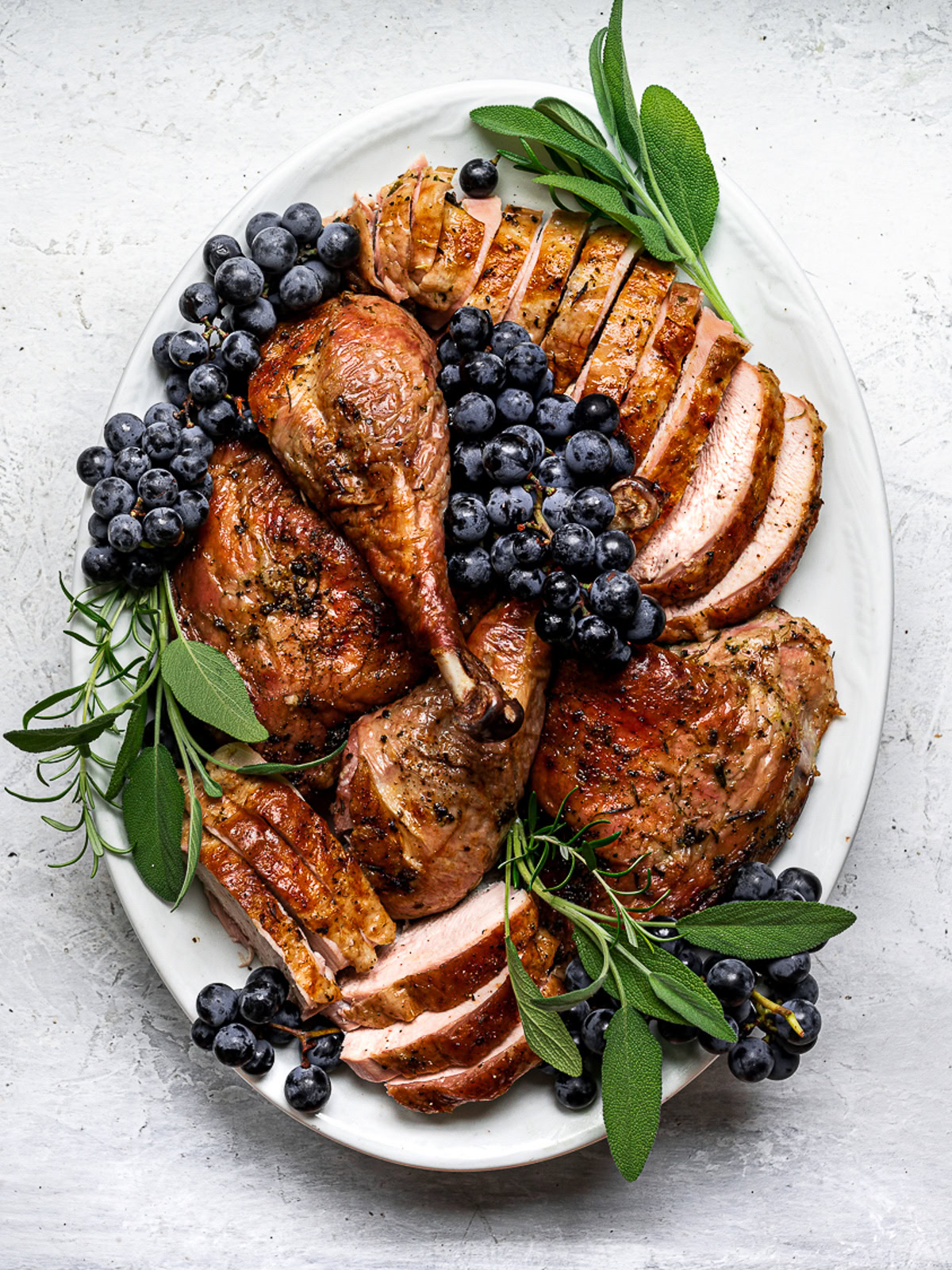
This post is meant to convince you of the many reasons to spatchcock a turkey. It’s so very worth it for its simple ease of preparation, time-savings, and most importantly, delicious flavour.
If you are in charge of making the turkey this year, you must try this superior method for cooking your bird. I guarantee your mind will be blown with how easy and delicious it is. Once you try it, you will never cook turkey any other way.
- What Is Spatchcock Turkey?
- Why Spatchcock A Turkey?
- How To Spatchcock A Turkey
- Tips for spatchcocking turkey
- Ingredient Notes
- What Size Turkey Is Best For Spatchcocking?
- Is Dry Brine Better Than Wet Brine?
- Best Salt For Dry Brining
- How To Dry Brine A Turkey
- How To Roast A Spatchcocked Turkey
- Tips for the best roast turkey
- More holiday dishes to love
- Spatchcock Turkey with Dry Brine
What Is Spatchcock Turkey?
I have a few other recipes on this site where I extol the advantages and virtues of spatchcocking a whole chicken. The same exact principles and techniques apply to a whole turkey.
The spatchcock technique involves cutting out the backbone of a whole turkey, or chicken to butterfly it. With the backbone removed, the bird will lay flat to cook. By laying flat, the thighs and drumsticks will now finish cooking at the same time as the breasts. In other words, no more dry breasts, and no more undercooked legs. YAY!
The best part? Spatchcocking a turkey is a simpler, quicker method to achieve a perfectly cooked, juicy, and succulent turkey. When I say quicker, I’m talking you will roast a whole turkey in only 90 minutes!
Perhaps the only drawback to a spatchcocked turkey is that it will not look as lovely as a whole roasted turkey on your holiday table. But have you ever really brought a whole, un-carved turkey to the table? Me either. Plus, take a look at the photo above of the finished presentation. It looks glorious, right? But better yet, it’s the most succulent turkey you’ll ever have.
Why Spatchcock A Turkey?
Not only is preparing and cooking a spatchcocked turkey easier than a whole turkey, it will also cook faster, cook more evenly and taste better.
If you still aren’t convinced, here all the advantages outlined:
- Even cooking: When the turkey is flattened, the legs and breast become an even surface. This allows the legs – which take the longest to cook – to be done at the same time as the breast.
- Higher heat: Because of the even cooking explained above, you no longer risk drying out the breast before the thighs are done. This allows you to roast the turkey at a higher temperature without burning, or drying out the breast. A spatchcocked turkey is cooked between 400ºF and 450ºF and is done in approximately 90 minutes. Genius!
- Crispier skin: All the skin is now exposed in one even layer which means it will crisp up evenly in the hot oven.
- Juicy dark AND white meat: Again, a flat turkey will cook evenly allowing both the dark and white meat to remain juicy and moist.
- Takes up less space in the oven: No need to remove racks to make space for a flattened turkey. This allows you to cook two turkeys at the same time, if needed.
- The backbone makes fantastic gravy : If you spatchcock the turkey you will have the turkey backbone to make an easy wonderful stock along with the giblets which makes a delicious gravy. If you order a spatchcocked turkey from a butcher, be sure to ask them to include the removed backbone with the turkey.
How To Spatchcock A Turkey
If you have access to a great butcher, they should be happy to spatchcock the turkey for you. Otherwise, spatchcocking a turkey is much easier than it sounds and the bit of initial effort will reward you plenty in the end.
Here’s how to do it:
- To remove the backbone, place the turkey, breast-side down on a large cutting board and cut down each side of the backbone, cutting all the way through to remove the backbone completely. Use a pair of poultry shears or sharp kitchen shears which will make this an easier task.
- Cut a small incision on the cartilage that is between the two breast bone. Now flip the turkey breast-side up and press hard on the breast to break the rib cage bone to flatten the breast even further. This short video is very helpful.
- Carefully place the flattened turkey, breast side-up on a prepared large sheet pan to apply dry brine.
- Save the turkey back and giblets to make gravy. You can make the gravy a day or two ahead from roasting the turkey.
Tips for spatchcocking turkey
- If you don’t have poultry shears, you may need to cut some smaller bones before cutting all the way through.
- As you’re cutting through the bone, you may find your scissors getting stuck. If this happens, try cutting even closer, or further, to the sides of backbone.
- It is best to start cutting from the tail end of the bird but if you are struggling, spin the bird around and cut from the neck end.
Ingredient Notes
This spatchcock turkey recipe includes a dry brine and an herby butter rub for roasting the turkey. The herbs are optional but they infuse the turkey with a lovely aroma and wonderful flavor.
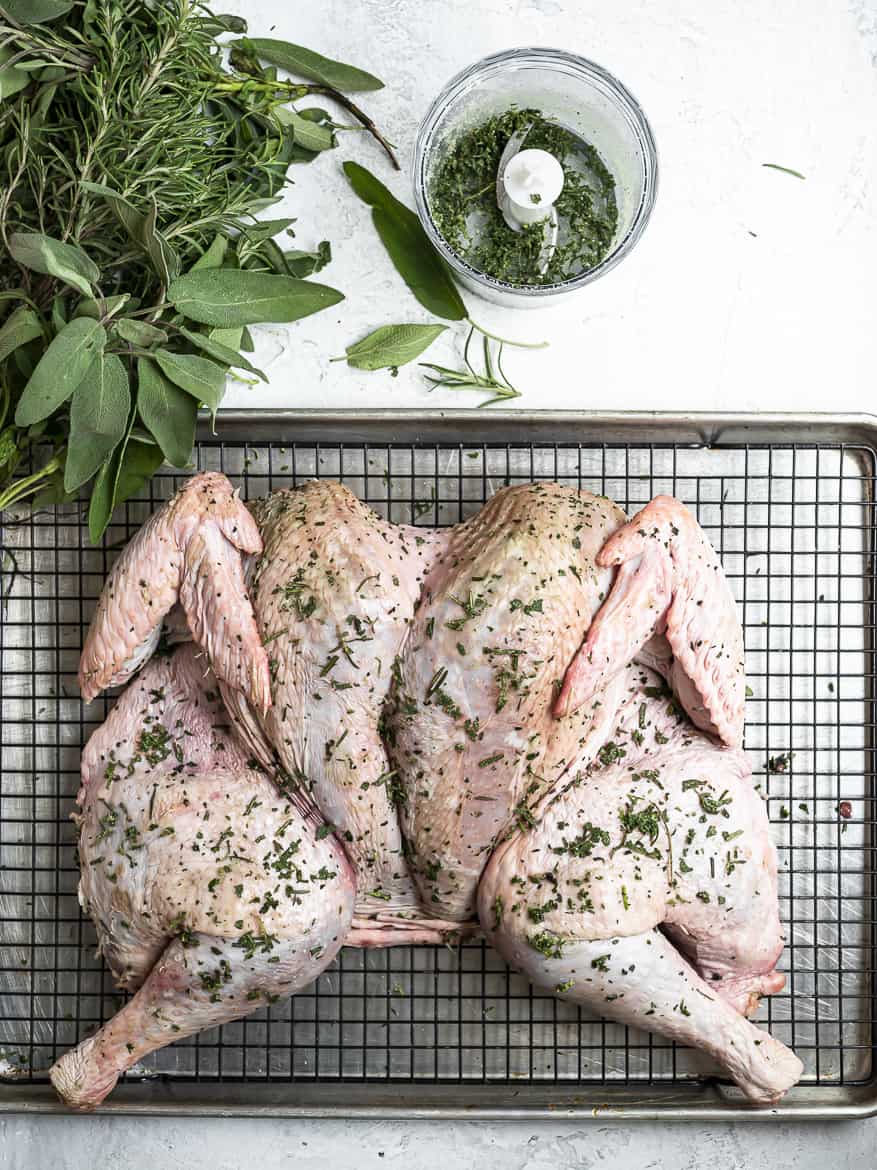
- Turkey: If possible, buy a turkey from a butcher or a market that sells natural turkeys. It is important to note that dry brining is not for self-basting or pre-seasoned turkeys.
- Dry brine: All you need is salt to dry brine your turkey. For more flavor, I like to also add chopped herbs such rosemary, sage, and thyme. Marjoram would also be lovely. See section below for more information on the salt you should use.
- Butter: Melted butter is rubbed all over the turkey to ensure it is super juicy and tastes even more glorious. You can use olive oil, if you prefer.
What Size Turkey Is Best For Spatchcocking?
Any size turkey will work for spatchcocking, but the smaller the bird, the easier it is to handle. A 12-14 lb turkey is ideal since anything larger will be hard to fit on a baking sheet.
If you’d like to cook a large spatchcocked turkey, make sure you have a commercial size baking sheet, or a very large roasting pan where it can lay flat. Commercial sheet pans, such as this one, typically measure 18×13 inches.
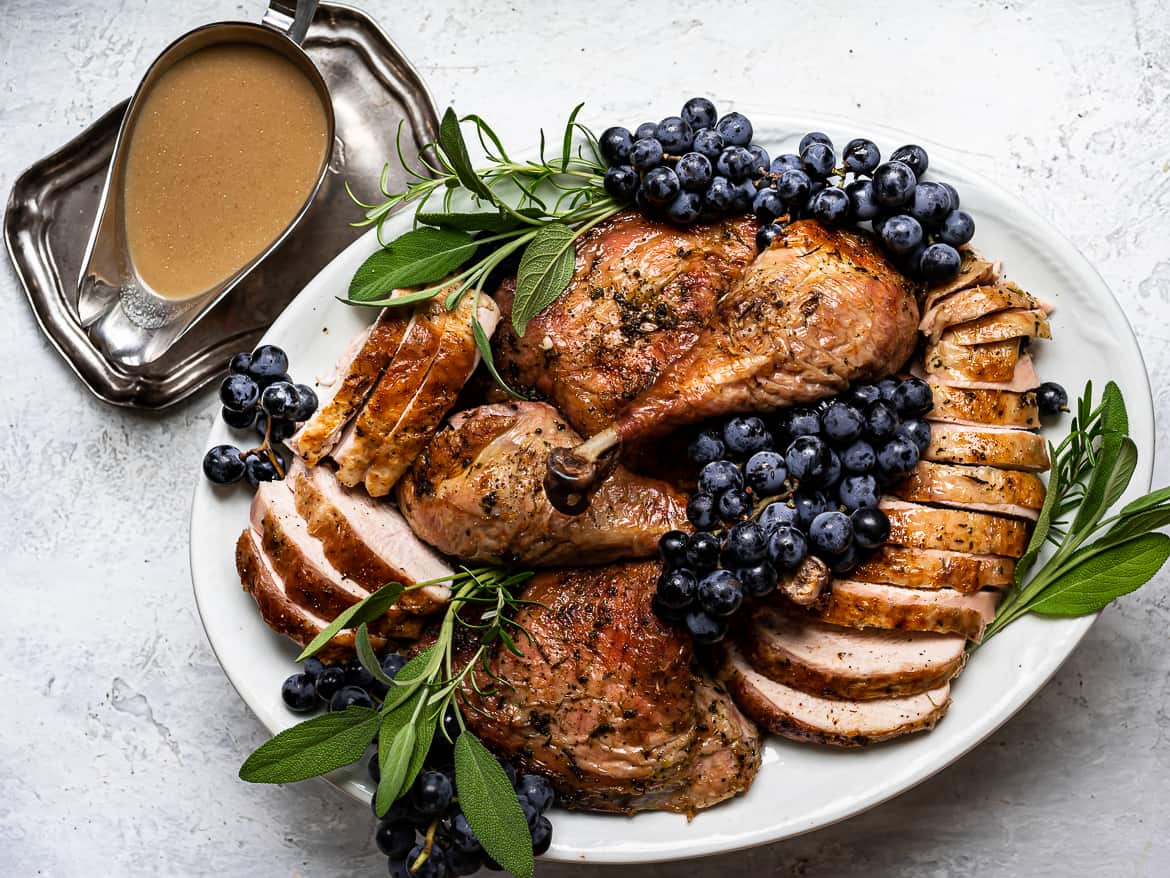
Is Dry Brine Better Than Wet Brine?
It is hard to infuse enough flavour into turkey meat without brining it and I much prefer a dry brine over a wet brine. In fact, I did a wet brine only once and never did it again. I won’t get into details but I have no desire to have a massive bucket filled with water and a turkey in my fridge ever again. What a nightmare.
A dry brine is a much easier, no-hassle method to add flavour to the turkey and it’s a sure way to ensure it stays crispy on the outside and juicy on the inside.
Essentially, a dry brine is simply rubbing the turkey down with a lot of salt and a few optional herbs, then letting it rest in the refrigerator for 24-72 hours. The salt changes the protein structure in the meat, causing it to release moisture then reabsorb it again resulting in perfectly juicy, tender, and flavourful meat.
Furthermore, placing the turkey with a dry brine in the fridge to air dry uncovered for at least 12 hours, will give your bird a beautiful, crispy, golden-coloured skin.
Best Salt For Dry Brining
Kosher salt is best for dry brining any meat. Table salt is a lot saltier and the small crystals will not work for dry brining.
Though any kosher salt will work for brining, it is important to not that the size and structure of the crystals will vary by brand. This variation will make some brands taste slatier than others so you need to adjust the amount used.
My preferred brand of Kosher salt is Diamond Crystal which has the perfect-sized grains and will not make the turkey too salty. If you use a different brand of Kosher salt such as Windsor, or Morton, which have larger salt granules, you will need to reduce the amount of salt given in this recipe by about 1-2 teaspoons.
How To Dry Brine A Turkey
Here are the simple steps to dry brine a turkey:
- Remove turkey from its packaging.
- Remove neck and giblets from the body cavity, reserving for stock and gravy, if desired.
- Set an oven-safe wire rack on top of a large baking sheet and place the spatchcocked turkey on top, skin side up. Use approximately 1 tablespoon of kosher salt per 5 pounds of turkey. Mix the salt with chopped fresh herbs, if you wish. Pat the bird dry inside and out, and then rub the salt mixture all over the skin, and the inside areas of the turkey as well.
- Cover with plastic wrap and refrigerate 24-72 hours. If you don’t have room in your fridge for a large baking sheet, place the turkey on a baking sheet to rub the dry brine, then transfer it to a large bowl. For really crispy skin, remove the plastic wrap 1 day before you plan on roasting the turkey. If you are dry brining for only 24 hours or less, leave uncovered the whole time.
NOTE: The turkey does not need to be rinsed before roasting. Rinsing the bird will wash off all the flavour and rehydrate the skin which defeats the purpose of dry brining. The turkey will not be too salty but if making gravy, hold off on adding any salt just to be safe.
How To Roast A Spatchcocked Turkey
Once your turkey is spatchcocked and brined, the rest of the process is quick and fuss-free.
1-2 HOURS BEFORE ROASTING:
- Remove turkey from the fridge and bring to room temperature. This step is important. A fridge-cold turkey will take longer to roast and will seize up in a hot oven. It takes at least 1 hour for a fridge-cold turkey to reach room temperature so be sure to plan ahead. Do not rinse the turkey!
ROAST THE TURKEY:
- Preheat oven. A half hour before the turkey is ready to roast, preheat the oven to to 450 degrees F.
- Place the room temperature turkey on a rack set inside a large rimmed baking. A shallow baking sheet does work best for roasting a spatchcocked turkey. If you don’t have one, you can use a large baking pan and scatter chunks of vegetables on the bottom so the turkey sits on top of them. The turkey should be spread out, skin side up. Tuck the wing tips under and turn the legs out.
- Melt 4 tablespoons butter. Brush all the skin with melted butter (or you could use olive oil). This will add lovely flavour, and colour, to the turkey.
- Roast. Place the turkey in the oven and pour 2 cups of water, or broth, in the pan. Roast at 450° F for 30 minutes, then lower the temperature to 400° and rotate the pan. Add a bit more water, if necessary. Roast until the internal temperature of the thickest past of the thigh reaches 165 – 170 degrees and the breast 155 – 160 degrees. A 14-pound turkey will take about 90-95 minutes. A 12-pound turkey may only need 80-85 minutes. A spatchcocked turkey is best cooked at a high temperature. If your oven is really hot (mine isn’t) you can lower the temperature to 375 degrees after 30 minutes.
- Rest the turkey. Remove the turkey from the oven and transfer it to a cutting board and tent with foil. Allow it to rest for 30 minutes (you can go a little longer, if necessary) before carving. This step is crucial for a juicy, perfectly cooked turkey. Strain the pan drippings to make gravy, if desired.
- Carve and serve!
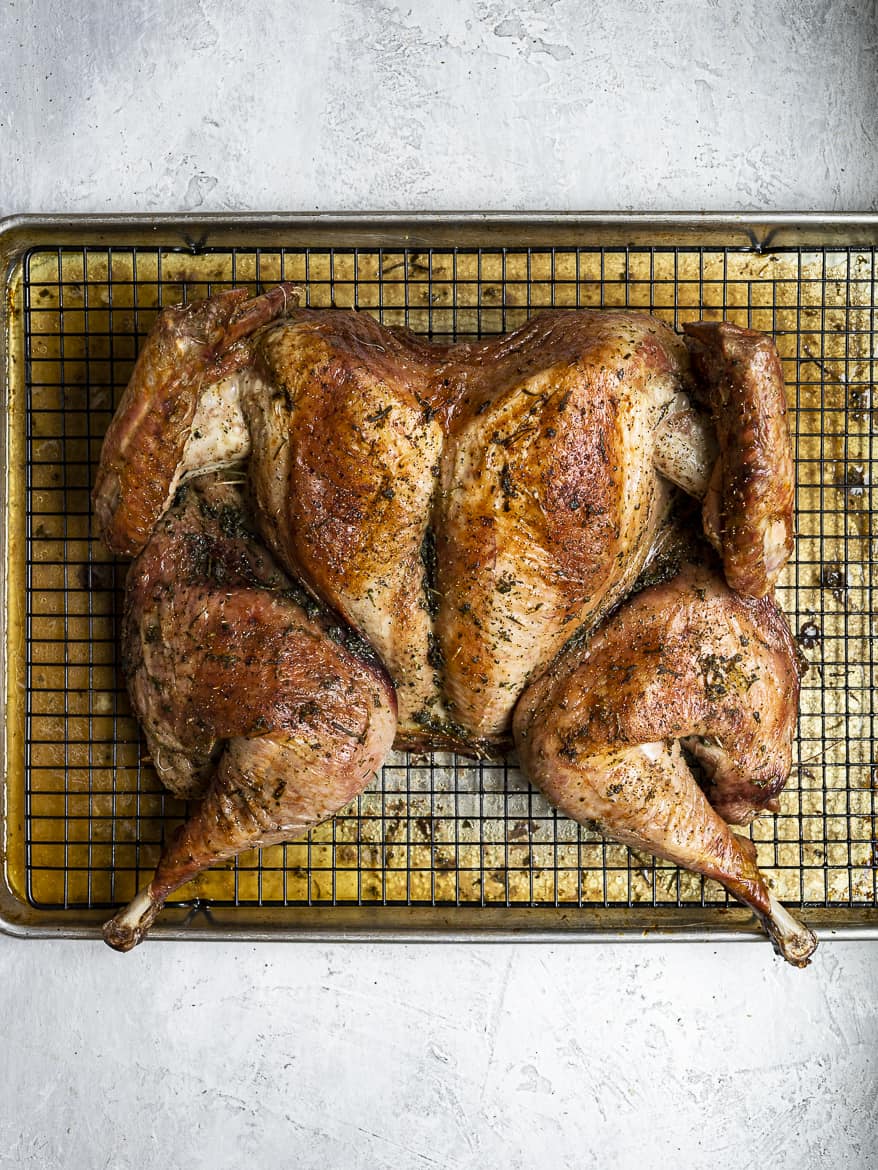
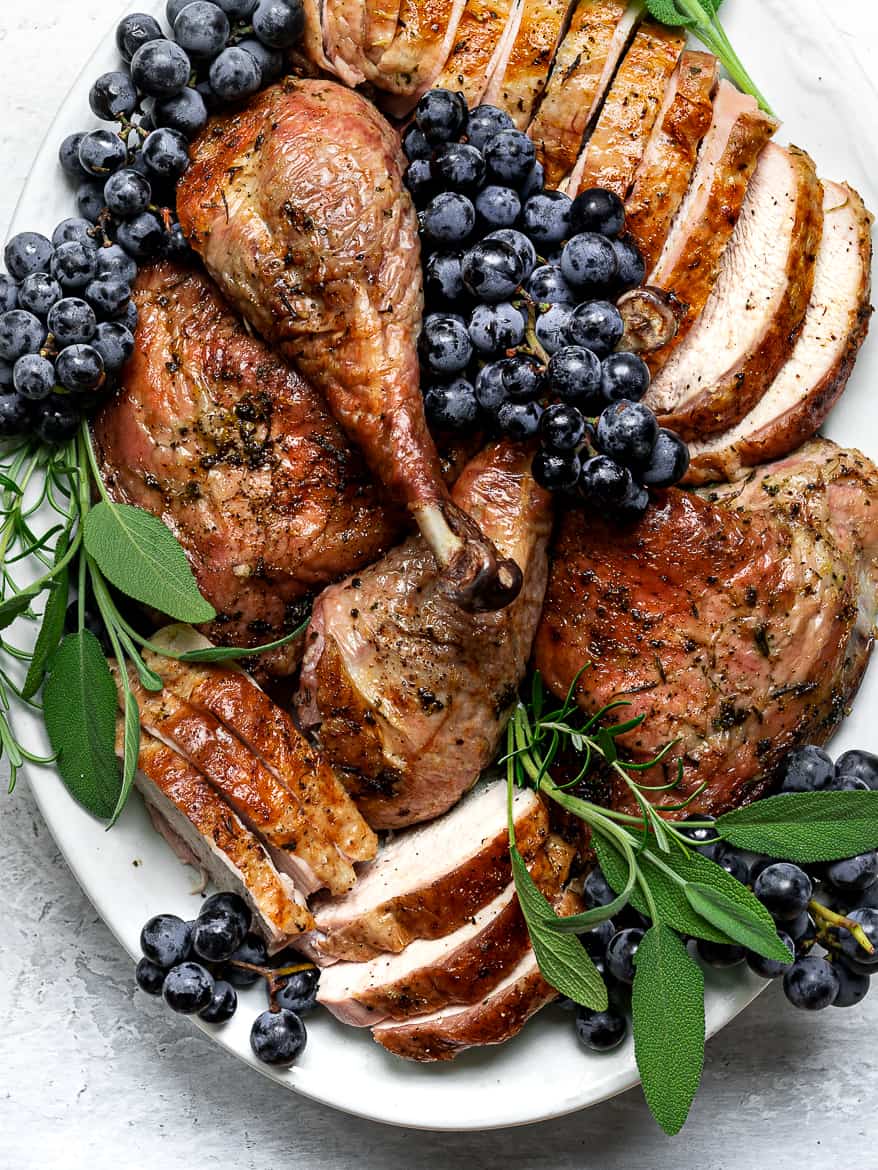
Tips for the best roast turkey
- Read over the recipe once or twice. Though the steps to roasting a spatchcocked turkey are simple, there is a lot of information and tips. Read over the recipe instructions and notes a few times to become a bit familiar with the whole method.
- Season simply. Because the spatchcocked turkey will roast at a high temperature, you want to keep the seasoning simple. Minced garlic, dijon marinades, etc, will burn too quickly. I added fresh herbs to the dry brine but even that is not necessary. Butter, salt, and pepper add plenty of flavour and gorgeous colour to the turkey.
- Use a meat thermometer. You cannot guess the temperature on this one. Use a reliable meat thermometer to ensure you don’t over cook or under cook the turkey. An instant read thermometer such as this one, works great. When inserting the thermometer into the meat, make sure it is not touching the bone to get an accurate reading.
- Add more water to roasting pan. To prevent pan drippings from burning, feel free to add more water or chicken broth to the pan.
- Sharpen your knife for carving. If you have the time to get your knives professionally sharpened, this would a great time to do it. It makes the job of carving the turkey a breeze.
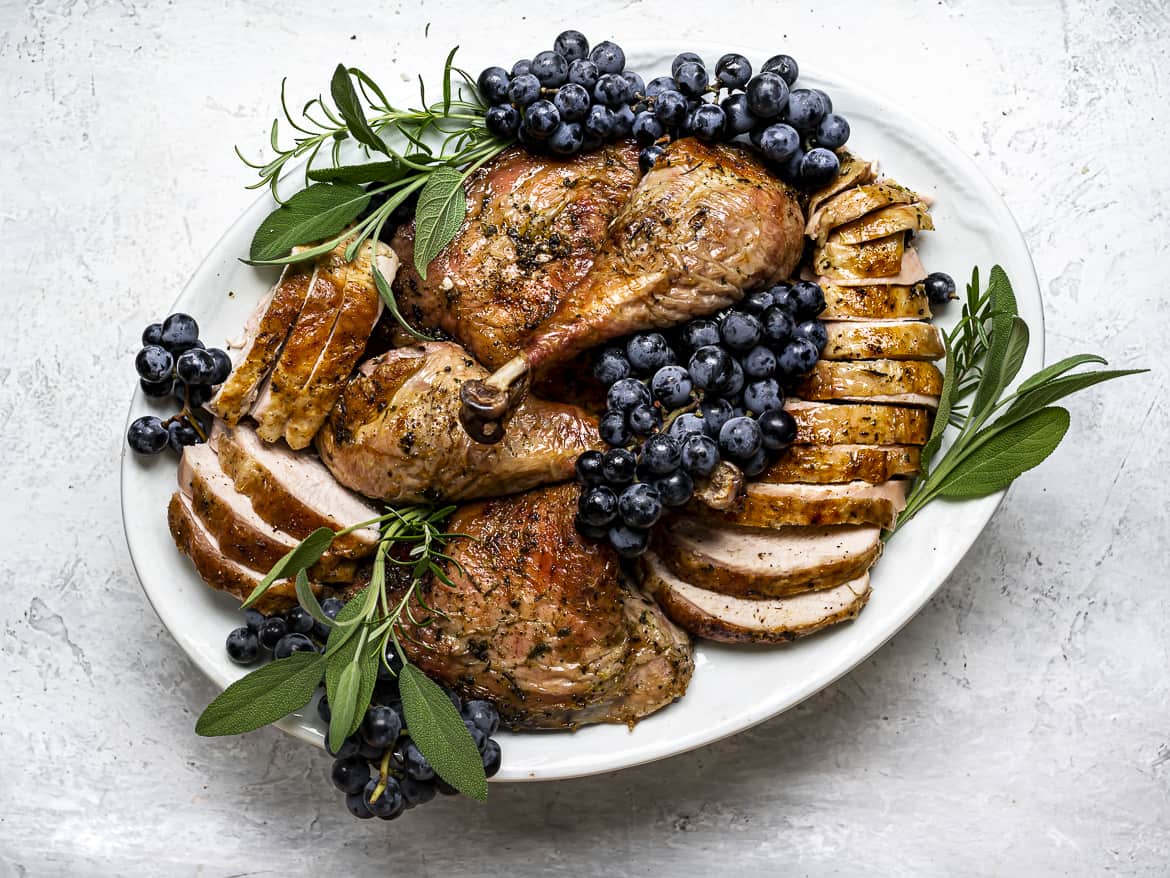
More holiday dishes to love
- Roasted Delicata Squash and Quinoa Salad
- Sweet Potato Gratin with Sage
- Crispy Brussel Sprouts with Agrodolce Sauce
Spatchcock Turkey with Dry Brine
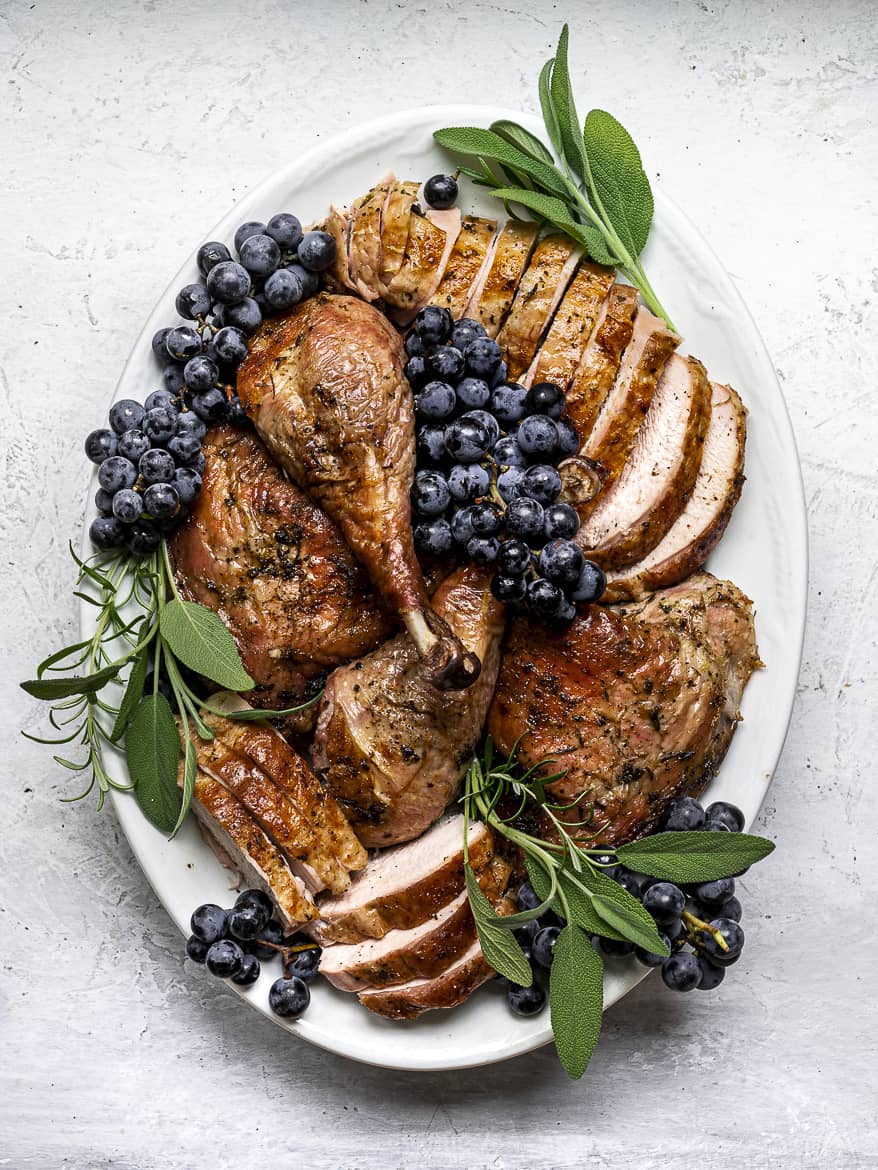
Ingredients
- 1 12-14 pound fresh turkey natural, organic, or free-range
For the dry brine
- 3 tablespoons Kosher salt (or 1 tbsp per 5 pounds) I use Diamond Crystal (*see notes)
- ¼ cup chopped fresh herb leaves and tender stems I used thyme, rosemary, and sage (optional)
To Roast the Turkey
- 6 Tablespoons melted unsalted butter or unrefined olive oil
- freshly cracked black pepper to taste
- 2 cups water, or chicken stock plus more if needed
Instructions
- Spatchcock The Turkey: If you can order a spatchcocked turkey from a butcher, do it! Be sure to ask for the backbone that was removed to use it to make stock. **See recipe notes for directions to spatchcock it yourself.
- Dry Brine The Turkey: Set a wire baking rack inside a large baking sheet (***see recipe notes if you don't have a large baking sheet, or can't fit one in your fridge). In a small bowl, combine the kosher salt and fresh herbs, if using. Place the turkey skin side up on the wire rack and pat dry the turkey inside and out with paper towels. Sprinkle the salt mixture evenly all over the outside and the underside of the turkey. Loosely cover with plastic wrap and place in the fridge for 1-3 days. 12-24 hours before you plan on roasting the bird, remove the plastic wrap and leave uncovered in the fridge.
- Prepare the turkey for roasting: Take turkey out of the fridge 60-90 minutes before you plan to start roast it. Preheat the oven to 450° degrees F 30 minutes before roasting the trukey (a large oven will take about 25-30 minutes to preheat). Once the turkey has come to room temperature, and the oven is preheated, tuck the wing tips under the breast and make sure the legs are spread out. Brush the turkey all over with the melted butter. Sprinkle with freshly cracked black pepper to taste.
- Roast: Place the turkey in the oven and pour 2 cups of water, or broth, in the pan. Roast at 450° F for 30 minutes, then lower the temperature to 400°. Carefully rotate the pan, and add a bit more water if necesary. Roast until the internal temperature of the thickest part of the thigh reaches 165 degrees and the breast 155 degrees. A 14-pound turkey will take about 90-95 minutes. A 12-pound turkey may only need 80-85 minutes so start checking early. If the turkey is browning too qucikly, just cover loosely with foil. Add more water or broth if the pan drippings are burning.
- Rest the turkey. Remove the turkey from the oven, transfer it to a cutting board, and tent with foil. Allow it to rest for 30 minutes (a bit longer is okay) before carving. Do not rush the resting period, this step is crucial for a juicy, perfectly cooked turkey. Strain the pan drippings to make gravy, if desired.
- Carve and serve! Serve with a make ahead gravy (recipe in notes) and favourite sides.
Notes
- Remove the neck and giblets from inside the turkey. Place the turkey, breast-side down on a large cutting board and cut down each side of the backbone, cutting all the way through to remove the backbone completely. Use a pair of poultry shears or sharp kitchen shears which will make this an easier task.
- Cut a small incision on the cartilage that is between the two breast bone. Now flip the turkey breast-side up and press hard on the breast to break the rib cage bone to flatten the breast even further. This short video is very helpful.
- Place the flattened turkey, breast side-up on a large sheet pan to apply dry brine.
- Save the turkey back and giblets to make gravy. You can make the gravy a day or two ahead from roasting the turkey.
- Depending on how hot your oven runs, and how big or small your turkey is, you may need more or less roasting time. Start checking the temperature after 75 minutes to gauge how much longer the turkey needs to roast.
- A spatchcocked turkey is best cooked at a high temperature. If your oven is really hot (mine isn’t) you can lower the temperature to 375 degrees after 30 minutes.
- If roasting two turkeys at once, set the oven to convection cooking, if possible. But be sure to reduce all temperatures by 25 degrees for convection.
- Warm 6 tablespoons of fat (add butter if necessary) in a medium-sized pot over medium heat.
- Whisk in the flour and cook until lightly golden, about 2-3 minutes.
- Slowly whisk in 4 cups of the turkey broth and all the reserved pan juices. Continue to whisk until smooth. Simmer until thickened, whisking occasionally about 5-10 minutes.
- Season to taste with salt and pepper. Store in the fridge, tightly covered, for up to 4 days. Reheat over low heat until warm, whisking occasionally.


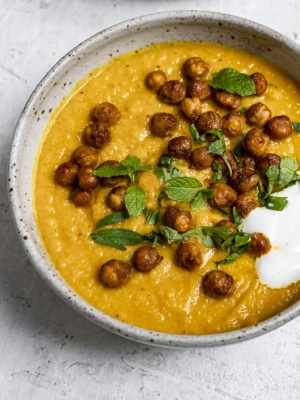
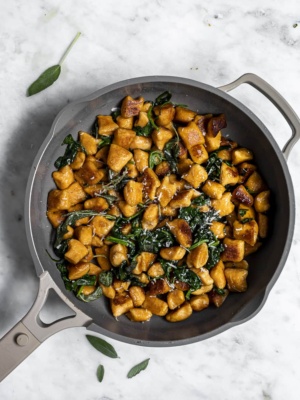

Michelle
Sandra thank you for the amazing recipe. We tried your spatchcock technique this past weekend and the results were fantastic. We may never go back to the traditional way of cooking a turkey! Many thanks.
Sandra Valvassori
Yay!! So wonderful to hear this Michelle! Thank you so much for sharing with us – it truly is a life-changing method :))
Rick Dunning
Love the spatchcocked turkey technique, any suggestions for grilling instead of oven roasting ??
Sandra Valvassori
You could absolutely grill a spatchcocked turkey but I have never tried it myself so I am not able to provide detailed instructions. You could, however, follow the instructions in my recipe for Grilled Piri Piri Chicken allowing more time depending on the size of your turkey. Cutting the turkey in half all the way through the breast (as I do with the piri chicken) would make it a lot easier to flip the turkey. Good luck and let me know if you give it a try!
Christina
This turned out SO well. So much better than a whole roasted turkey for Thanksgiving. It roasted much more evenly, and quicker. This is my go-to now, thank you!
Sandra Valvassori
Woohoo! So happy to hear that, Christina! Thank you so much for making this recipe, and for your kind review.